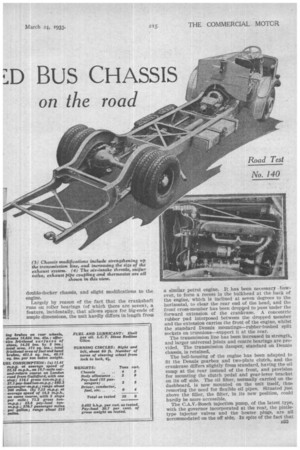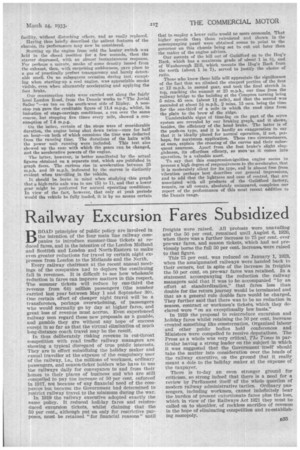Impressions of
Page 46

Page 47

Page 48

Page 49

If you've noticed an error in this article please click here to report it so we can fix it.
A NEW DENNIS OILENGIT
D Bus CHASSIS
on the road
AS recently announced in The Commercial Motor, Dennis Bros., Ltd., Guildford, has come to an arrangement with Armstrong-Saurer Commercial Vehicles, Ltd., London' and Newcastle, to share with the latter company the sole rights to use British-built Armstrong-Saurer oil engines in passenger chassis. The first machine to have such a power unit installed is the subject of this road-test report. Lance and Lancet chassis will be made with six and four-cylindered units respectively; it is with the former that we are immediately concerned. For the chassis illustrated, an all-steel 52-seater body is in course of construction by Metropolitan-Cammell-Weymann Motor Bodies, Ltd., Vickers House, Westminster, London, S.W.T. To accommodate the six-cylindered Armstrong-Saucer compression-ignition unit, which has the latest type of " cross-flow " head and weighs only 1,570 lb., certain alterations have been made to the standard Lance n32 double-decker chassis, and slight modifications to the engine.
Largely by reason of the fact that the crankshaft runs on roller bearings (of which there are seven), a feature, incidentally, that allows space for big-ends of ample dimensions, the unit hardly differs in length from a similar petrol engine. It has been necessary however, to form a recess in the bulkhead at the back of the engine, which is inclined at seven degrees to the horizontal, to clear the rear end of the head, and the front cross-member has been droned to pass under the forward extension of the crankcase. A concentric rubber pad interposed between the dropped member and the extension carries the front of the engine, whilst the standard Dennis mountings—rubber-bushed split sockets on trunnions—support it at the rear.
The transmission line has been increased in strength, and larger universal joints and centre bearings are provided. The transmission damper, standard on Dennis chassis, is retained.
The bell-housing of the engine has been adapted to fit the Dennis gearbox and two-plate clutch,and the crankcase differs slightly from standard, having the oil sump at the rear instead of the front, and provision for mounting the clutch pedal and gear-lever bracket on its off side. The oil filter, normally carried on the dashboard, is now mounted on the unit itself, thus removing the need for flexible oil pipes. Situated just above the filler, the filter, in its new position, could hardly be more-accessible.
The C.A.V.-Bosch injection pump, of the latest type, with the governor incorporated at the rear, the pintletype injector valves and the beater plugs, are all accommodated on the off side. In spite of the fact that
the driver's compartment is beside the engine, access can be gained to them by a sliding bonnet side, which can be instantly lifted. Incidentally, the whole pump unit is readily detachable. The illustration showing these components was obtained with the driver's seat removed.
On the same side of the engine is the water pump; its lubricator is not inaccessible, although situated low down at the front. A feature of the pump is the use of a spring-loaded self-adjusting, carbon-block-type gland.
Current is supplied to the heater plugs from a separate two-volt battery placed under the driver's seat, where it is close to the engine, with the resulting advantage that there is little drop in voltage due to line losses. The plugs are interconnected with the starter, in such a way that the engine cannot be started up unless the heaters are switched on.
Two Autopulse pumps feed fuel, from the 30-gallon tank on the off side of the chassis, through a C.A.V.-Bosch filter, to the injection pump, and it should be noted that the first-named are placed practically at fuel level, where, we understand, they have been found to function more effectively than when placed above the tank. It is also worthy of mention that the fuel feed is in a practically straight line, and that it is on the opposite side of the vehicle to the exhaust.
In connection with the exhaust system it is of interest that the diameter
of the pipe, for its entire length, has been increased from 2 ins, to 2* ins., and that a larger silencer is used for the Armstrong-Saurer engine. There is, too, a remarkably neat fixing for the
pipe to the manifold. It consists of an inverted, swinging Li piece caerying a single setscrew, the former being hinged to the manifold whilst the latter bears upon a boss at the first bend of the pipe, which it holds firmly in position. On the production chassis a 24-volt 0.A.V.-Bosch dynamo with 1,000-watt 'teed for 800-watt lamp load will be employed ; on the machine we tested a 12-volt instrument was used. We understand that these two dynamos are the same size. An impression of the dimensions of the latter may be gained from one of the accompanying pictures. A Smith It.P. thermostat is incorporated in the upper water connection.
Particularly interesting is the Dewandre-Lockheed braking system. To create the required vacuum a throttlo valve is incorporated in the air-intake manifold, the latter having a branch connected to the Dewandre cylinder and communicating with the atmosphere by a snifter valve.
A simple mechanism, incorporating a lost-motion box (distinguishable in the illustration of the off side of the engine), provides that the intake throttle is fully closed during the first motion of the brake pedal. As the last-named is normally operated by the same foot as the accelerator, when the throttle is closed, the injector control will be in the idling position, for which condition sufficient air for combustion without' smoking is admitted to the cylinders by the snifter valve. No reservoir is employed in the system.
One last detail of the chassis that, although no longer a novelty, should not be overlooked is the junction box mounted on -the end of the bulkhead behind the driving seat, and to which is led every electrical connection. Encased in a circular aluminium box, the cover of which is secured by a single wing-nut, all terminals clearly named, for switches, dynamo, batteries, interior lights, headlamps, side lamps and the rest are arranged radially, the connections from terminal to terminal being made permanently at the back. Thus, when wiring up, the possibility of an error being made is reduced to a minimum, and any lead, or set of leads, to any item in the electrical equipment can be disconnected with the utmost facility, without disturbing others, and as easily replaced. Having thus briefly described the salient features of the chassis, its performance may now be considered.
Starting up the engine from cold the heater switch was held in the closed Position for a few seconds, then the starter depressed, with an almost instantaneous response. For perhaps a minute, smoke of • some density issued foam , the exhaust, then, with surprising suddenness, gave place to a gas of practically perfect transparency and barely detect able Knell. On no subsequent occasion during test, excepting when starting-up a cool engine, was appreciable smoke visible, even when alternately accelerating and applying the foot brake.
Our consumption tests were carried out along the fairly level London Road, from the Dennis works to. "The Jovial Sailor "—an inn on the south-west side of Ripley. A nonstop run gave the creditable figure of 11.4 m.p.g., whilst, in imitation of stage-carriage conditions, a run over the same course, but stopping five times every mile, showed a consumption of 7.4 m.p.g.
On the latter, certain of the stops were of considerable duration, the engine being shut dawn twice—once for half an hour—on both of which occasions the time was deducted from the running time. The durations of the halts with the power unit running were included. This test also showed up the ease with which the gears can be changed, and the accelerative powers of the engine.
The latter, however, is better manifested by the actual figures obtained on a separate test, which are published in graph form. The curious rise in acceleration between 25 m.p.h. and 3() m.p.h. indicated by the curves is distinctly evident when travelling in the vehicle.
It should be borne in mind when studying .this graph that a high-ratio axle was in use (5)r to 1), and that a lower gear might he preferred for normal operating conditions. In view of the fact, however, that only at peak periods would the vehicle he fully loaded, it is by no means certain that to employ a lower ratio would tie more economic. That higher speeds than those calculated and shown in the accompanying panel were obtained seems to point to the governor on this chassis being set to cut out later than the maker of the engine advises. Our ascents of the hill out of Guildford on to the Hog's Back, which has a maximum grade of about 1 in SI, and of Wauborough Hill, which mounts the Hog's Back from the north (about 1 in 7), served to justify the choice of ratio.
Those who know these hills will appreciate the significance of the fact that we climbed the steepest portion of the first at 32 m.p.h. in second gear, and took the final stretch in top, reaching the summit at 23 m.p.h., our time from the railway bridge to the building at the Compton turning being 5 mins. 45 secs. (about 1 mile), and that the second was ascended at about 5/ m.p.h., 2 mins. 15 secs. being the time for the one-third of a mile in which the road rises from the plain to the brow of the ridge: Unmistakable signs of time-lag on the part of the servo system are revealed by our braking graph, and it shows, besides, the efficiency of the hand brake. The latter is of the push-on type, and it is hardly an exaggeration to say that it is ideally placed for normal operation, if not, per
haps, for maximum application. These two circumstances, at once, explain the crossing of the curves and their subsequent nearness. Apart from the foot brake's slight sluggishness, its effortless efficacy, so soon -as it comes into operation, is a valuable asset.
To say that this compression-ignition engine seems to possess a high degree of responsiveness to the accelerator, that it is moderately silent for its type, and is almost free from vibration perhaps best describes our general impressions, and to add that the lightness and ease of control, that are
associated with all products of the Guildford factory, remain, on all counts, absolutely unimpared, completes our report of the performance of this most recent addition to the Dennis range.




























































































